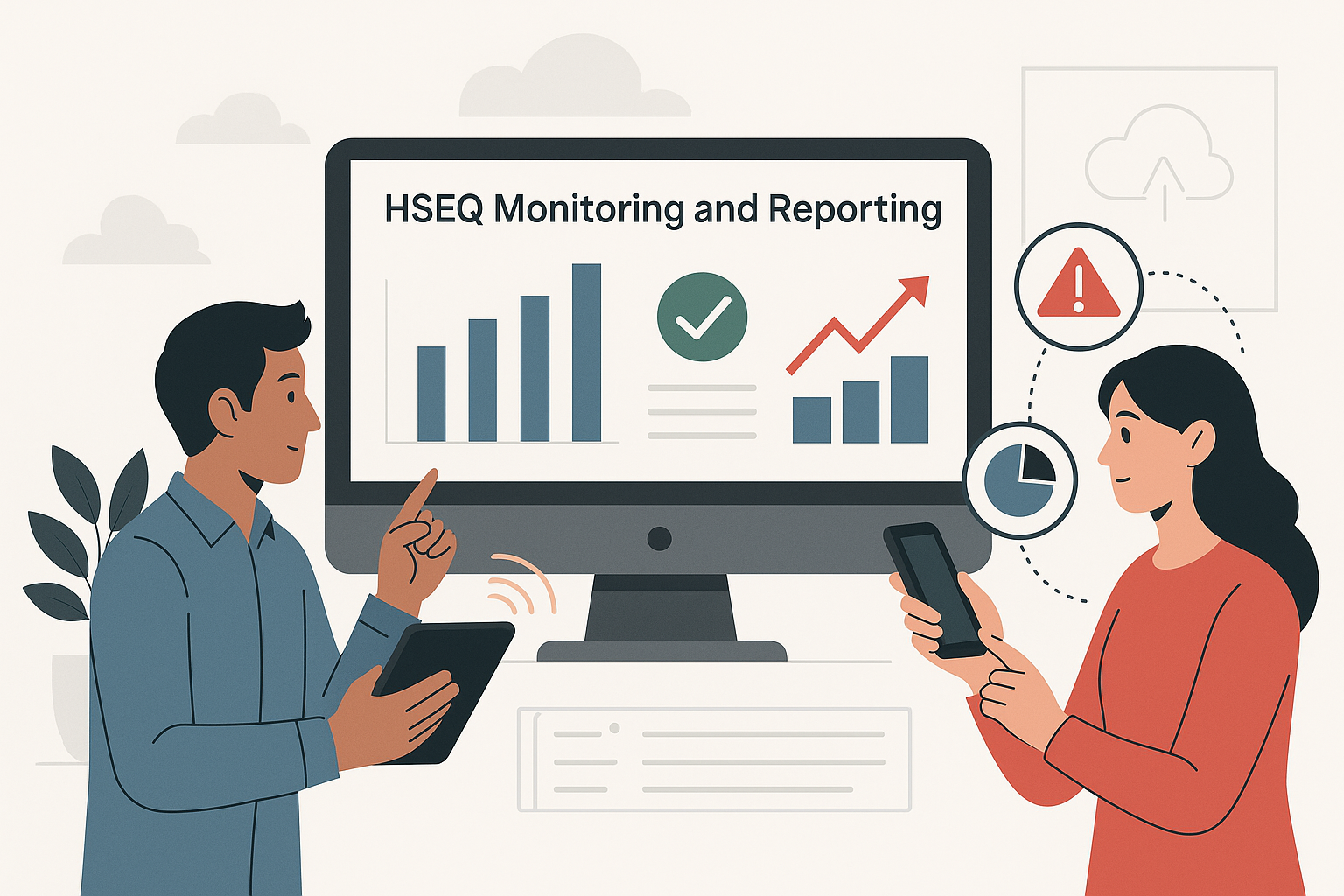HSEQ Monitoring and Reporting have undergone a massive transformation in the digital era. Gone are the days of paper checklists, spreadsheet chaos, and delayed data entries.
Today, businesses are leveraging cutting-edge digital tools to streamline how they track, manage, and improve their Health, Safety, Environment, and Quality (HSEQ) performance.

This article explores the latest digital innovations reshaping HSEQ processes, their key features, and how these tools enhance compliance, reduce incidents, and drive continuous improvement.
Why Go Digital in HSEQ Monitoring and Reporting?
Manual HSEQ systems are prone to:
- Human error
- Delayed updates
- Inconsistent reporting
- Data loss or duplication
In contrast, digital tools offer real-time insights, automated workflows, centralized data, and performance dashboards — making them indispensable in industries such as construction, oil & gas, manufacturing, healthcare, logistics, and maritime.
Key Benefits of Digital HSEQ Monitoring and Reporting
1. Real-Time Data Collection
Digital tools allow safety officers and quality inspectors to capture incidents, near-misses, and audit data in real time using tablets, smartphones, or connected devices. This reduces reporting delays and ensures immediate corrective actions.
2. Automated Alerts and Workflows
Modern systems can trigger automated:
- Notifications for non-compliances
- Assignments for corrective actions
- Escalations to management
- Reminders for pending inspections or training
Automation improves accountability and response times.
3. Customizable Dashboards and KPIs
Digital HSEQ platforms offer visual dashboards that help managers instantly view:
- LTIFR and TRIFR trends
- Environmental emissions
- Quality rejection rates
- Training completion stats
This supports data-driven decision-making.
4. Cloud-Based Centralization
All HSEQ data — from multiple sites or departments — is stored in the cloud. This enables:
- Access from any device or location
- Secure backup and version control
- Seamless collaboration across teams
Cloud platforms reduce the burden of emailing reports and spreadsheets back and forth.
5. Regulatory and Standards Compliance
Many tools are pre-configured to align with:
They support audit trails, permit tracking, and automated reporting for easier compliance.
6. Mobile Accessibility
Field workers can now complete:
- Safety checklists
- Near-miss reports
- Toolbox talks
- Audit forms
…from any smartphone or tablet, with offline functionality available in many apps.
Top Digital Tools for HSEQ Monitoring and Reporting
Here are some of the most widely adopted digital platforms in the HSEQ world:
1. iAuditor by SafetyCulture
- Drag-and-drop audit builder
- Real-time reporting with photos and notes
- Offline functionality for remote sites
- Integration with Power BI and Slack
Ideal for site inspections, audits, and safety checks.
Visit iAuditor (DoFollow)
2. EcoOnline
- Specialized in chemical safety and environmental compliance
- Risk assessments and SDS management
- Supports ISO 14001 compliance
- Dashboard for emissions and waste tracking
Great for industries handling hazardous substances.
Visit EcoOnline (DoFollow)
3. ETQ Reliance
- Enterprise-level Quality and HSEQ management
- Workflow automation
- Document control and CAPA tracking
- Supplier quality management
Best for large organizations requiring scalable quality systems.
Visit ETQ (DoFollow)
4. Intelex
- Modular design for environment, safety, and quality
- Mobile-enabled inspections and analytics
- AI-powered incident investigations
- Regulatory content libraries
Highly customizable and used across sectors.
Visit Intelex (DoFollow)
5. Enablon by Wolters Kluwer
- EHSQ, sustainability, and risk modules
- Advanced reporting tools
- Predictive analytics and trend tracking
- Global compliance support
Perfect for enterprise ESG and HSEQ integration.
Visit Enablon (DoFollow)
Internal & External Resources
- Read our article on Top HSEQ Metrics – OHSE.ca
- Explore our HSEQ Audit Guide – OHSE.ca
- Learn more about PDCA Continuous Improvement – ASQ (DoFollow)
- Review Canadian OHS Regulations (DoFollow)
Best Practices for Implementing HSEQ Digital Tools
- Start with a pilot program
Test the tool in one department or site. - Train your staff properly
Provide both hands-on and virtual training sessions. - Define clear KPIs
Know what you want to track and improve. - Choose mobile-friendly platforms
Field usability is essential for accuracy. - Ensure data security and compliance
Use tools that are GDPR- and ISO-compliant.
Final Thoughts on HSEQ Monitoring and Reporting
Digital transformation is reshaping how organizations handle HSEQ monitoring and reporting.
With the right tools in place, companies gain real-time visibility, improved compliance, and a safer, more efficient workplace. Embracing digital platforms isn’t just an upgrade — it’s a strategic move that drives performance, sustainability, and accountability.
Let technology do the tracking — so your people can focus on doing the right things, safely and efficiently.
Leave a Reply